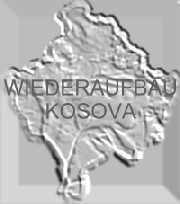Inhalts-Verzeichnis
Kosovo + Kosova = Kosov@
werden vermittelt bei

http://www.osnabrueck.
netsurf.de:8080/~dbein/
wiederaufbau.htm
|
Inhalts-Verzeichnis |
||
|
Kosovo + Kosova = Kosov@ |
werden vermittelt bei 
http://www.osnabrueck. netsurf.de:8080/~dbein/ wiederaufbau.htm |
|
Unofficial Summary of press briefing on Kosovo damage assessmentsLink to new albanian map of Kosova Link to detailed new map of Kosova 197 KB
UNHCR/European Community/KFOR
From KFOR Headquarters 27 July 1999
Unofficial Summary of press briefing on Kosovo damage assessments
UNHCR/European Community/KFORFrom KFOR Headquarters 27 July 1999
Roy Dickson of European Commission:
The EC was co-chairing the first donors conference on Kosovo, to be held on 27 July in Brussles. That conference will have four aims – to inform donors on the urgent needs of Kosovo; to determine how best those needs could be met; to begin the task of looking beyond the humanitarian crisis to reconstruction; and to develop ways for the donors to work together to provide for the long term needs of Kosovo. It was absolutely crucial at the conference that donors have a clear picture of what needs to be done and that picture should be based on hard evidence, not just on impressionistic judgements. That’s why the European Commission, UNHCR and KFOR have been working on a scientific and rigorous assessments of the damage done to Kosovo over the last few months.
The EC study surveys 204,585 housing units in 1,300 villages in all 29 municipalities. It found:
- 119,500 houses were damaged, and 78,000 of those were completely destroyed.
- 534 schools were damaged and 189 of those were destroyed
- 240 healthcare facilities were damaged, 83 were either destroyed or badly damaged.
- 617 villages had their electric supply damaged.
- 440 villages had damaged water supply.The EC estimated total reconstruction costs at:
- For housing to be 1,116 million euros;
- For schools 20 million euros;
- For health facilities 7 million euros;
- For local electricity distribution 10 million euros;
- For local water supply 5 million euros;He stressed that those figures were not the cost of reconstructing Kosovo -- but just the cost of replacing housing and local services. To rebuild airports, roads and factories will take much more funding. He also indicated that those figures where at the higher end of the estimates and the actually contributions needed from the international community was estimated at 800 million euros.
While much attention by correspondents was focused on the costs of reconstruction, there was a humanitarian reality behind the costs – upwards of 500,000 people may not have adequate shelter this winter in an area where the temperatures can reach –25 c. "A second humanitarian crisis is waiting to happen unless the donor community can mobilize significant resources," he said.Bob Turner of UNHCR:
The second installment of the "Kosovo Rapid Village Assessment" survey covers 456 villages. The assessment process is ongoing and another installment of the survey would probably be issued in a few more weeks. Its findings corroborate what the EC had found.
In December 1998, a humanitarian survey was taken and found that 60 percent of houses in damaged villages were not destroyed completely. During the recent assessment, UNHCR found that 75 percent of the houses had some damage and 40 percent were completely destroyed. That clearly demonstrate that the destruction in Kosovo was systematic and wide-spread.
Of those people who continue to be displaced within Kosovo, 82 percent said they can not go home because their houses were destroyed. UNHCR’s assessment also found that 50 percent of villages relied on humanitarian assistance for their food. Data on crop production indicated that the wheat crop this year will be 40 percent of the average crop. In addition, UNHCR and partners have handed out 3,000 shelter kits, 12,000 tents that shelter 10 people each, 29,000 plastic sheets, 400,000 blankets and 300,000 mattresses. The humanitarian community is getting materials out to refugees and internally displaced people.Mike Neighbor of KFOR:
KFOR has decided that it would not conduct a separate survey but it would help other agencies in their own surveys. Such assessments and help would continue. An important part of the military contribution in the surveys came from the United States Imagery and Mapping Agency which took satellite photos of 272,000 buildings in Kosovo. That survey found that 68,000 homes were severely damaged. However, that was a low estimate because satellites only measure the number of houses without roofs. Buildings can be severely damaged and still have a roofs on them.
Questions:
Asked what was the difference between the donor conference in Brussels and the donor conference in Sarajevo, Mr. Dickson said the Brussels conference would focus only on Kosovo contributions, while in Sarajevo the focus will be on peace and stability in the Balkans as a region.
For information only—not an official record
Contact UNMIK Press and Information Office—mobile (99 41 79) 217 3094